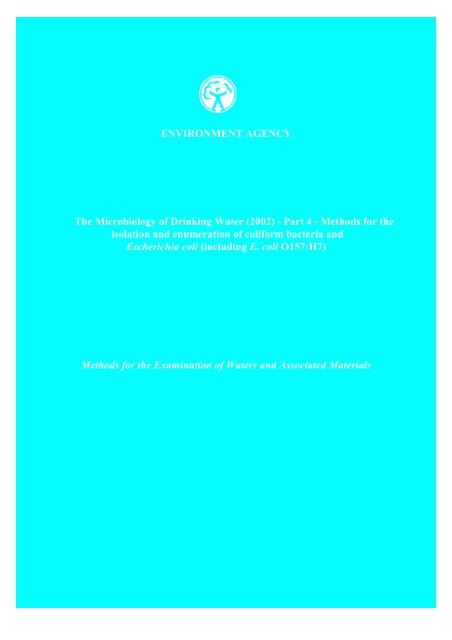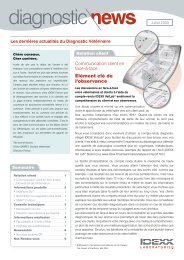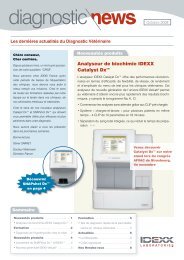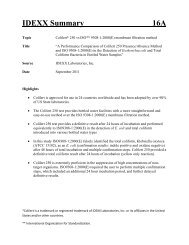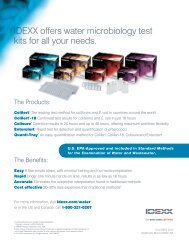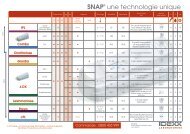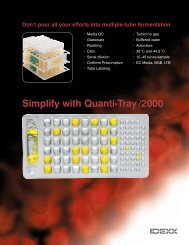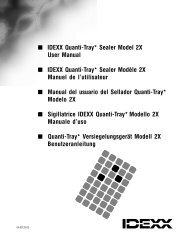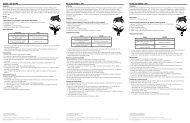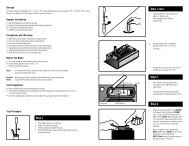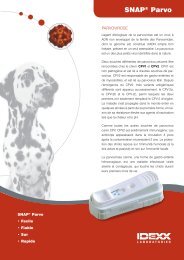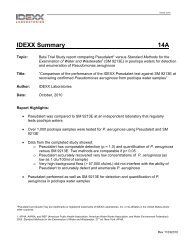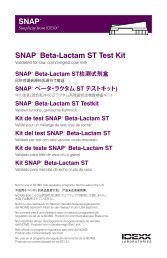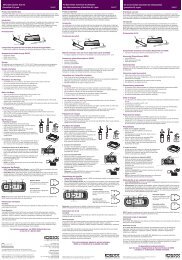ENVIRONMENT AGENCY The Microbiology of Drinking Water (2002)
ENVIRONMENT AGENCY The Microbiology of Drinking Water (2002)
ENVIRONMENT AGENCY The Microbiology of Drinking Water (2002)
- No tags were found...
Create successful ePaper yourself
Turn your PDF publications into a flip-book with our unique Google optimized e-Paper software.
<strong>ENVIRONMENT</strong> <strong>AGENCY</strong><strong>The</strong> <strong>Microbiology</strong> <strong>of</strong> <strong>Drinking</strong> <strong>Water</strong> (<strong>2002</strong>) - Part 4 - Methods for theisolation and enumeration <strong>of</strong> coliform bacteria andEscherichia coli (including E. coli O157:H7)Methods for the Examination <strong>of</strong> <strong>Water</strong>s and Associated Materials
DD1<strong>The</strong> enumeration <strong>of</strong> coliform bacteria and Escherichia coli by a defined substratemost probable number techniqueIntroductionTests for coliform bacteria and Escherichia coli (E. coli) are the most importantroutine microbiological examinations carried out on drinking water. <strong>The</strong>y provide themost sensitive means for detecting faecal contamination, for assessing theeffectiveness <strong>of</strong> water treatment and disinfection, and for monitoring water quality indistribution. <strong>The</strong> significance <strong>of</strong> E. coli and coliform bacteria in water treatment andsupply are described elsewhere (1) in this series.D2ScopeThis method comprises a most probable number (MPN) technique and is suitable forthe examination <strong>of</strong> drinking waters, including samples from all stages <strong>of</strong> treatmentand distribution, and those source waters <strong>of</strong> moderate to high turbidity.Users wishing to employ this method, or similar methods from other manufacturers,should verify the performance under their own laboratory conditions (2) . Details <strong>of</strong>evaluation trials are reported elsewhere (3) .D3DefinitionsDefined substrate media are chemically defined formulations containing substrates forthe specific detection <strong>of</strong> diagnostic enzymes associated with a particular group <strong>of</strong>organisms.In the context <strong>of</strong> this method, organisms which are oxidase-negative and produceβ-galactosidase, as demonstrated by the production <strong>of</strong> a yellow colour through theenzymatic cleavage <strong>of</strong> ortho-nitrophenyl-β-D-galactopyranoside in a defined substratemedium, are regarded as coliform bacteria. In addition, organisms which produceβ-glucuronidase, as demonstrated by the production <strong>of</strong> a yellow colour and blue-whitefluorescence (under long wavelength ultra-violet illumination) through the enzymaticcleavage <strong>of</strong> 4-methylumbelliferyl-β-D-glucuronide in a defined substrate medium, areregarded as E. coli.Coliform bacteria are considered to be members <strong>of</strong> genera or species within theFamily Enterobacteriaceae, capable <strong>of</strong> growth at 37 °C, that possess β-galactosidase.This definition includes anaerogenic (ie non-gas producing) strains. <strong>The</strong> followinggenera have been commonly isolated in routine practice: Citrobacter, Enterobacter,Escherichia, Hafnia, Klebsiella, Serratia, Yersinia, Buttiauxella, Leclercia.For the purposes <strong>of</strong> water examination E. coli have historically been regarded asmembers <strong>of</strong> the Family Enterobacteriaceae which ferment lactose or mannitol at 44 °Cwith the production <strong>of</strong> acid within 24 hours, and which produce indole fromtryptophan. Most strains produce β-glucuronidase. Strains which possess thesecharacteristics at 37 °C but do not express them at 44 °C may also be E. coli. When44
identified as E. coli they have the same sanitary and operational significance withregard to their faecal origin.D4PrincipleOrganisms are grown in a defined liquid medium containing substrates for the specificdetection <strong>of</strong> the enzymes β-galactosidase and β-glucuronidase. <strong>The</strong> dehydratedmedium is dissolved in 100 ml <strong>of</strong> sample, or dilution <strong>of</strong> sample, which is then addedto a 51-well reaction pouch. This is then sealed and incubated at 37 °C for up to 22hours. If, within the pouch, some <strong>of</strong> the wells exhibit no growth in the medium afterincubation, while other wells exhibit some growth, then the most probable number <strong>of</strong>organisms in 100 ml <strong>of</strong> sample can be estimated from appropriate probability tables,see table D1.D5LimitationsThis method is suitable for most types <strong>of</strong> aqueous samples. Those with highturbidities, however, may mask or impede colour development. <strong>The</strong> presence <strong>of</strong> veryhigh numbers <strong>of</strong> Aeromonas may result in false positive reactions.D6Health and safetyMedia, reagents and bacteria used in this method are covered by the Control <strong>of</strong>Substances Hazardous to Health Regulations (4) and appropriate risk assessmentsshould be made before adopting this method. Standard laboratory microbiology safetyprocedures should be followed and guidance is given elsewhere (2) in this series.When ultra-violet lamps are used gloves and either goggles or a face shield suitablefor use with appropriate ultra-violet-emitting sources should be worn.D7ApparatusStandard laboratory equipment should be used which conforms to the performancecriteria outlined elsewhere (2) in this series. Principally, fan assisted incubators arerequired. An example <strong>of</strong> the methodology for this type <strong>of</strong> method is presented and isbased upon a commercially available system. Some <strong>of</strong> the equipment listed is specificto this system and alternative systems may be available for which other equipmentmay be required. Other items include:D7.1 Sterile sample bottles <strong>of</strong> appropriate volume, made <strong>of</strong> suitable material,containing sufficient sodium thiosulphate pentahydrate to give a finalconcentration in the sample <strong>of</strong> not less than 18 mg/l (for example, 0.1 ml <strong>of</strong> a1.8 % m/v solution <strong>of</strong> Na 2 S 2 O 3 .5H 2 O per 100 ml <strong>of</strong> sample, or equivalent).D7.2 Incubator capable <strong>of</strong> maintaining a temperature <strong>of</strong> 37.0 ± 1.0 °C.D7.3 Sterile 100 ml plastic bottles containing anti-foaming agent as supplied by themanufacturer <strong>of</strong> the test system or suitable equivalent.45
D7.4 MPN reaction pouches as supplied by the manufacturer (for example, a 51-wellsystem) and associated heat-sealing equipment.D7.5 Ultra-violet long wavelength (365 - 366 nm) lamp, and viewer.D7.6 Colour and fluorescence comparator as supplied by the manufacturer.D8Media and reagentsCommercial formulations <strong>of</strong> these media and reagents are available. <strong>The</strong> performance<strong>of</strong> all media and reagents should be verified prior to their use. Variations in thepreparation and storage <strong>of</strong> media should also be verified.D8.1 Colilert® 18 medium (5) .<strong>The</strong> medium is a commercially available formulation provided in sachets and issuitable for single samples. <strong>The</strong> medium is a chemically defined formulation withminimal nutrients and substrates for the specific detection <strong>of</strong> the enzymesβ-galactosidase and β-glucuronidase.D9Analytical procedureD9.1 Sample preparation<strong>The</strong> volume, or dilution, <strong>of</strong> samples should be chosen so that not all the wells show apositive response. For treated waters, 100 ml <strong>of</strong> sample will generally be appropriate,whilst for contaminated waters, appropriate dilutions should be prepared, and 100 ml<strong>of</strong> diluted sample used. When preparing dilutions use sterile distilled, deionised orsimilar grade water. Buffered solutions should not be used as they may adverselyaffect the performance.D9.2 Sample processing<strong>The</strong> sample, or appropriate dilution, (usually 100 ml) is decanted into a sterile bottlecontaining anti-foaming agent. Following the manufacturer’s instructions, the contents<strong>of</strong> one sachet <strong>of</strong> medium is then aseptically added. After capping the bottle, thecontents are gently agitated to ensure dissolution <strong>of</strong> the medium and then the bottle isleft to stand, typically, for a few minutes to allow completion <strong>of</strong> dissolution anddispersal <strong>of</strong> any air bubbles. <strong>The</strong> contents <strong>of</strong> the bottle are then added to the MPNreaction pouch, which is then sealed in the apparatus provided by the manufacturer toproduce a 51-well reaction pouch. Prolonged exposure <strong>of</strong> the inoculated reactionpouch to direct sunlight should be avoided as this may result in hydrolysis <strong>of</strong> thespecific substrates causing false-positive reactions. <strong>The</strong> time between the inoculation<strong>of</strong> the reaction pouch and the beginning <strong>of</strong> the incubation stage should be as short aspossible and no longer than 2 hours.Sealed MPN reaction pouches are then incubated, ‘well-side’ down, at 37 °C for notless than 18 hours and not more than 22 hours.46
D9.3 Reading <strong>of</strong> resultsAfter incubation, the pouch is examined and the number <strong>of</strong> wells that have a sufficientyellow colour, compared against the manufacturer’s comparator, is recorded. <strong>The</strong>pouch is then re-examined under an ultra-violet long wavelength lamp and the number<strong>of</strong> wells, that produce a blue-white fluorescence <strong>of</strong> sufficient intensity comparedagainst the manufacturer’s comparator, is recorded. If the pouch is examined beforethe completion <strong>of</strong> 22 hours incubation and this examination reveals borderlineresponses, then it should be returned to the incubator for the remaining incubationperiod. After 22 hours incubation, the pouch is removed and re-examined as before.D9.4 Confirmation testsThis method is reported to be highly specific for coliform bacteria (yellow colorationin the wells) and E. coli (blue-white fluorescence in the wells). Hence, confirmationtests are not usually required. Should there be any doubt as to the type <strong>of</strong> organismand response detected, then wells showing a positive response should be sub-culturedand confirmatory tests undertaken.D10CalculationsD10.1 Confirmed coliform bacteria and E. coli<strong>The</strong> MPN <strong>of</strong> coliform bacteria is determined by reference to appropriate probabilitytables, see for example table D1. This is derived from the number <strong>of</strong> wells showing apositive, yellow coloration. For example, if there are 31 wells showing a yellowcoloration in the reaction pouch, then from table D1, the MPN <strong>of</strong> coliform bacteria is48 per 100 ml <strong>of</strong> sample, or diluted sample, examined. Any dilution needs to be takeninto account.<strong>The</strong> MPN <strong>of</strong> E. coli is determined by reference to the same probability table. This isderived from the number <strong>of</strong> wells showing a positive blue-white fluorescence. Forexample, if there are 12 wells showing a blue-white fluorescing in the reaction pouchthen, from table D1, the MPN <strong>of</strong> E. coli is 14 per 100 ml <strong>of</strong> sample, or diluted sampleexamined. Any dilution needs to be taken into account.D11Expression <strong>of</strong> resultsConfirmed coliform bacteria and E. coli counts are expressed as MPN counts pervolume <strong>of</strong> sample. For drinking water, the volume is typically 100 ml.D12Quality assuranceNew batches <strong>of</strong> media should be tested with appropriate reference strains <strong>of</strong> targetbacteria (for example, E. coli and Enterobacter aerogenes) and non-target bacteria(for example, Aeromonas hydrophila and Pseudomonas aeruginosa). Pouches shouldbe incubated for 18 - 22 hours at 37 °C. Further details are given elsewhere (2) in thisseries.47
D13References1. Standing Committee <strong>of</strong> Analysts, <strong>The</strong> <strong>Microbiology</strong> <strong>of</strong> <strong>Drinking</strong> <strong>Water</strong> (<strong>2002</strong>)- Part 1 - <strong>Water</strong> Quality and Public Health. Methods for the Examination <strong>of</strong> <strong>Water</strong>sand Associated Materials, in this series, Environment Agency.2. Standing Committee <strong>of</strong> Analysts, <strong>The</strong> <strong>Microbiology</strong> <strong>of</strong> <strong>Drinking</strong> <strong>Water</strong> (<strong>2002</strong>)- Part 3 - Practices and Procedures for Laboratories. Methods for the Examination <strong>of</strong><strong>Water</strong>s and Associated Materials, in this series, Environment Agency.3. Standing Committee <strong>of</strong> Analysts, Evaluation trials for two media for thesimultaneous detection and enumeration <strong>of</strong> Escherichia coli and coliform organisms1998, Methods for the Examination <strong>of</strong> <strong>Water</strong>s and Associated Materials, in this series,Environment Agency.4. <strong>The</strong> Control <strong>of</strong> Substances Hazardous to Health Regulations 1999, StatutoryInstrument 1999 No. 437.5. IDEXX Laboratories, Milton Court, Churchfield Road, Chalfont St Peter,Buckinghamshire, SL9 9EW.48
Table D1MPN (and 95% confidence intervals) per 100 ml for a 51-well definedsubstrate medium reaction pouchNumber <strong>of</strong> wellsshowing apositive reactionMPNper100 ml95 %confidencelimitsNumber <strong>of</strong> wellsshowing apositive reactionMPNper100 ml95 %confidencelimits0 0 0-4 26 36 25-541 1 0-6 27 38 26-572 2 1-7 28 41 28-603 3 1-9 29 43 30-634 4 2-11 30 45 32-665 5 2-12 31 48 33-696 6 3-14 32 50 35-737 8 4-16 33 53 38-768 9 5-17 34 56 40-809 10 5-19 35 59 42-8410 11 6-21 36 62 45-8911 12 7-22 37 66 47-9412 14 8-24 38 70 50-9913 15 9-26 39 74 53-10514 16 10-28 40 78 56-11115 18 11-29 41 83 60-11816 19 12-31 42 89 64-12617 21 13-33 43 95 68-13518 22 14-35 44 101 73-14619 24 15-37 45 109 79-15920 25 17-39 46 118 85-17521 27 18-42 47 130 93-19522 29 19-44 48 145 102-22423 31 20-46 49 165 115-27224 32 22-49 50 201 136-38825 34 23-51 51 >20149


